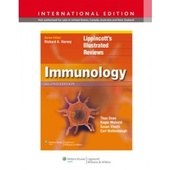
Lippincott s Illustrated Reviews: Immunology offers a highly visual presentation of essential immunology material,
with all the popular features of the series: over 300 full-color annotated illustrations, an outline format, chapter
summaries, review questions, and case studies that link basic science to real-life clinical situations.
Lippincott's Illustrated Reviews: Immunology can be used as a review text for a short immunology course,
or paired with Lippincott's Illustrated Reviews: Microbiology for a combined microbiology/immunology course.
--NEW ANCILLARY: Bank of 5-10 animations--ANCILLARY: 300 USMLE-style questions in a quizbank for students--ANCILLARY:
Fully searchable online text on thePoint--ANCILLARY: Image bank--FACULTY ANCILLARY: Library of individual image
components from which instructors can assemble their own figures in PowerPoint.
UNIT 1: SENSE OF BEING: THE CONCEPT OF SELF AND SELF/NON-SELF RECOGNITION
Chapter 1: The Need for Self Recognition
Chapter 2: Antigens and Receptors
UNIT II: THE INNATE IMMUNE SYSTEM
Chapter 3: Barriers to Infection
Chapter 4: Cells of the Innate Immune System
Chapter 5: Innate Immune Function
UNIT III: THE ADAPTIVE IMMUNE SYSTEM
Chapter 6: Molecules of Adaptive Immunity
Chapter 7: Cells and Organs
Chapter 8: Generation of Immune Diversity: Lymphocyte Antigen Receptors
Chapter 9: Lymphocyte Development: B Cells and T Cells
Chapter 10: Lymphocyte Activation
Chapter 11: Lymphocyte Function
Chapter 12: Regulation of Adaptive Responses UNIT IV: CLINICAL ASPECTS OF IMMUNITY
Chapter 13: The Well Patient, Or How Innate and Adaptive Immune Responses Maintain Health
Chapter 14: Hypersensitivity States
Chapter 15: Immunodeficiency
Chapter 16: Autoimmunity
Chapter 17: Transplantation
Chapter 18: Immune Pharmacotherapy
Chapter 19: Tumor Immunity
Chapter 20: Measurement of Immune Function NOTE: Each chapter includes an Overview, a Chapter Summary, Study Questions,
and Answers and Explanations.


